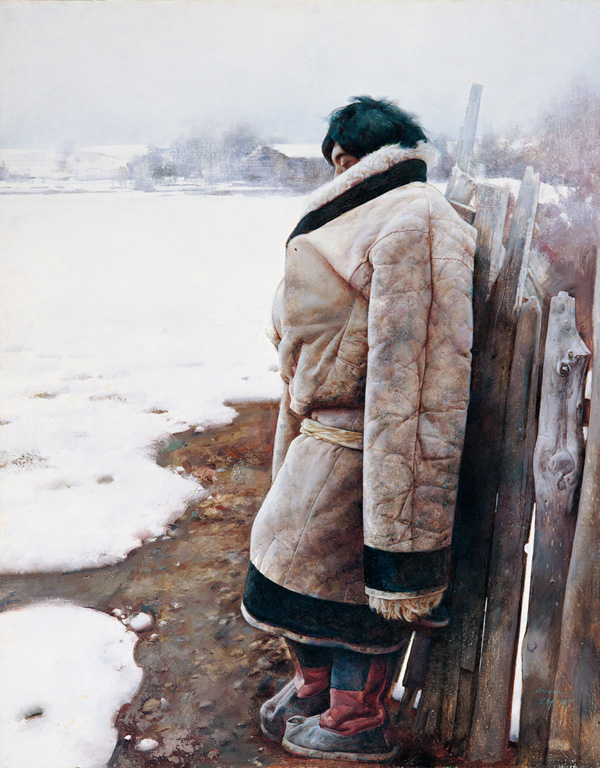ILLUSTRATED:
Li Fang & Ma Li ed., Estheticism-Celebrated Painters Series I, Yang Liu Qing Painting Publishing, Tianjin, 2005, color illustrated, p.120
Ai Xuan Xieshi Zhuyi Youhua Jiqiao, Beijing Art & Crafts Publishing House, Beijing, 2003, color illustrated, p.15
This painting is to be sold with a certificate of authenticity issued by Pan-long Art Culture Ltd.
Catalogue Note:
Scenes Like Paintings
Text / Li Chiao
In the 1980's, Ai Xuan gradually decided upon his chosen artistic subject as a painter of the nativist realism school. The Tibetan Plateau became his artistic inspiration, with its characters and scenery becoming seemingly his emotional symbolism - a barren landscape encased in ice and snow, the Tibetan assailed on all sides by cold and isolation, the crackling frost with every step, the chilling winds rustling through the wilted weeds - conveying an oppressive silence that approaches from afar. In the painting, an indescribable feeling of loneliness and isolation permeates the canvas. This also showed that Ai Xuan as a painter has found on the desolate Tibetan Plateau a medium through which to express himself.
The land locked in snow seems to be shrouded in that tranquility and isolation unique to the region. The Tibetan stands wordlessly beside the fence. His inner feelings, like his surroundings, are impossible to truly approach. Instead, the painting is filled with a sense of mystery that reaches every corner just like the winter snow. Only in the imagination surrounded by the tranquility of ice and snow does the song seem so moving, making one close their eyes in contemplation - the lingering snow, the lone person, the fence - they are recreated once again in Ai Xuan's "Sounds Getting Away". The artist has also imbued a greater depth of emotional projection into the scene. In actual fact the artist has always had a master plan for his artworks. The painting "Sounds Getting Away" is itself a part of this master plan. There is no doubt that Ai Xuan's shadow can be found in the painting delivering his soliloquy. His oil painting "Sounds Getting Away", like his other masterpieces, uses the scene to convey his feelings. By depicting the Tibetan Plateau's scenery and the lone person, he is in fact laying bare his inner emotional universe. Standing there alone in an endless expanse of snow-covered fields, lonely, helpless, thinking silently and quietly while viewing the world through a lens of apathy and unfamiliarity - the sense of emotional desolation represents space, silence and its resonance. That nameless loneliness radiates from the character in the painting and its overall atmosphere.
"Sounds Getting Away" once again emphasizes Ai Xuan's artistic choice and style. On the surface, it seems to be a reflection of the artist's unique life experience, with the multiple visits to the Tibetan Plateau due to the attraction of its scenery and its awe-inspiring nature. Yet in his eyes, the Plateau is not filled with joy and sunlight. It is instead isolated and mysterious. So rather than say that the artist has selected a theme for his landscapes, it is more appropriate to say that the artist has chosen an emotional symbol. Further examination reveals that Ai Xuan has taken a fresh approach by combining the emotions of loneliness and the beauty of mystery within his artistic envelope.
In this spiritual dimension, the artist has used the sense of mystery and loneliness that he is particularly adept at together with a lively and sophisticated realism to achieve an expression of creativity. During this process, the painter had refined the techniques of realism to their peak, combining the real and the virtual at will. This suggests that the artist's mastery of realism is not grounded in the form and structure of objects, but instead selectively emphasizes the allure of oil paintings. The spaces captured by the outlines as well as the changes in the effect, texture and tone of the shapes seems to result in a subtle touch that expresses the aesthetics of the painting's language, becoming the true artistic theme hidden within the imagery. This is what the artist often expends great effort to arrange and also the highlight of his artwork that draws the eye. Ai Xuan's unique status among the many contemporary artists that use Tibet as their theme can in fact be attributed to his invaluable care and reserve. Rather than forced compositions or paintings of oddities, the painter instead seeks to restore the real experience. This draws not only on his life experiences but also gives them order, resulting in an attractive reservation within the artwork. The audience is transported into an enduring, silent and mysterious artistic atmosphere where the expression of thought and visual representations are like an arrow notched to the bow with the bowstrings straining. This makes the artwork seem even more powerful.
This is why Ai Xuan's oil painting language without doubt shows the artist's achievement through the accumulation of experience and skill. "Sounds Getting Away" is proof that the artist has through his method of expression created a native China unique to Ai Xuan. This is what the artist uses to depict the scenes like paintings that exist within his inner world.
